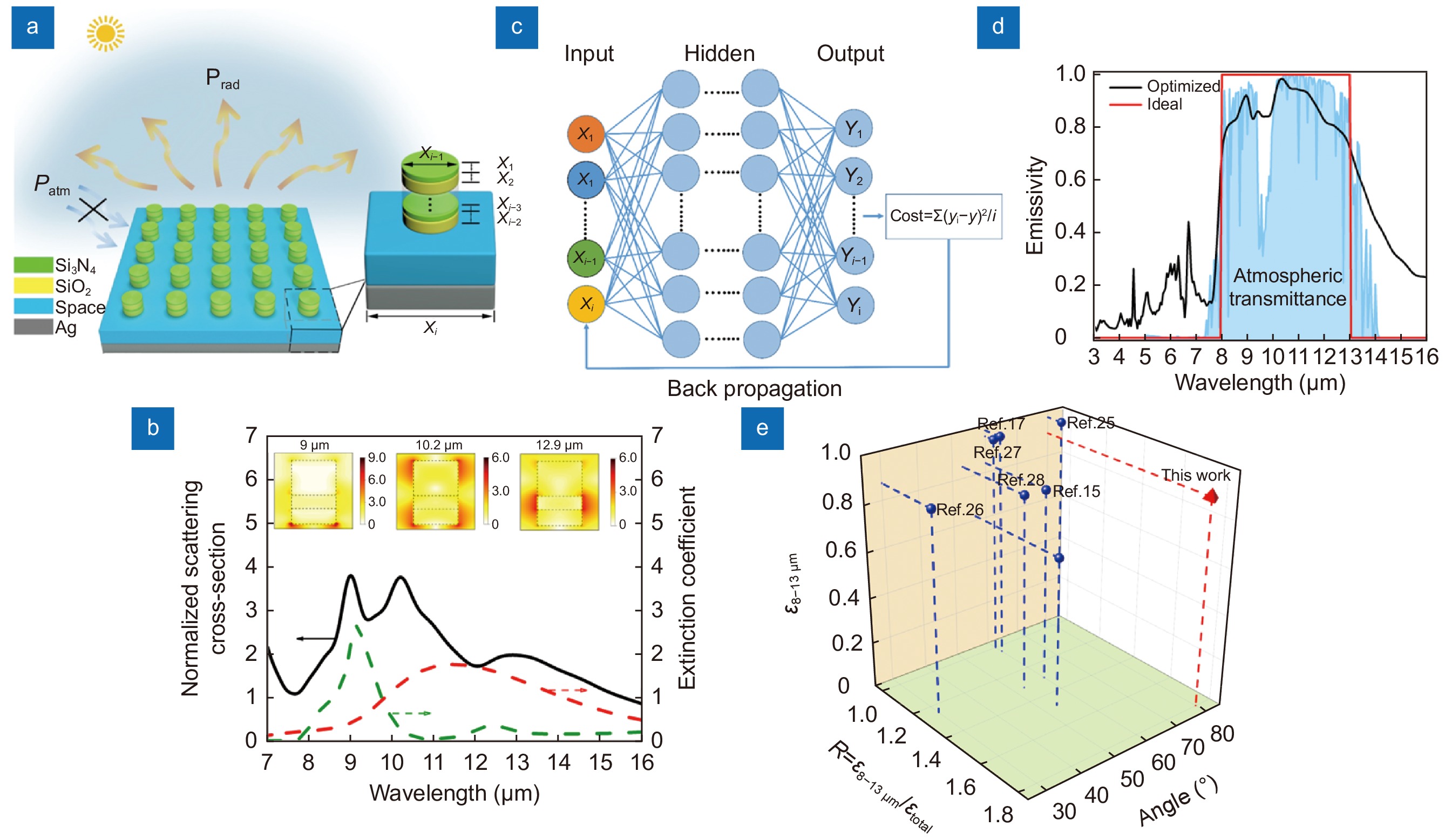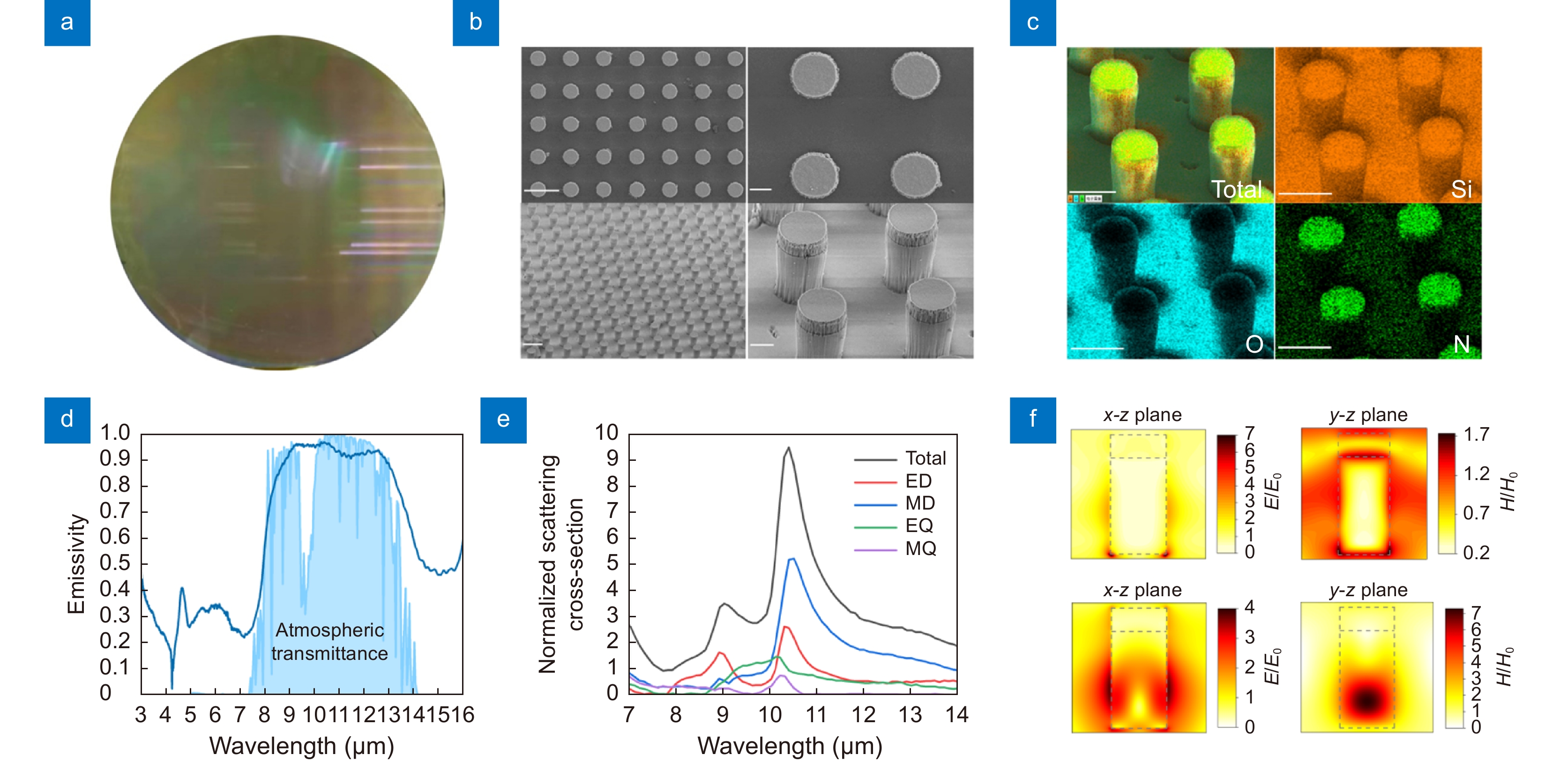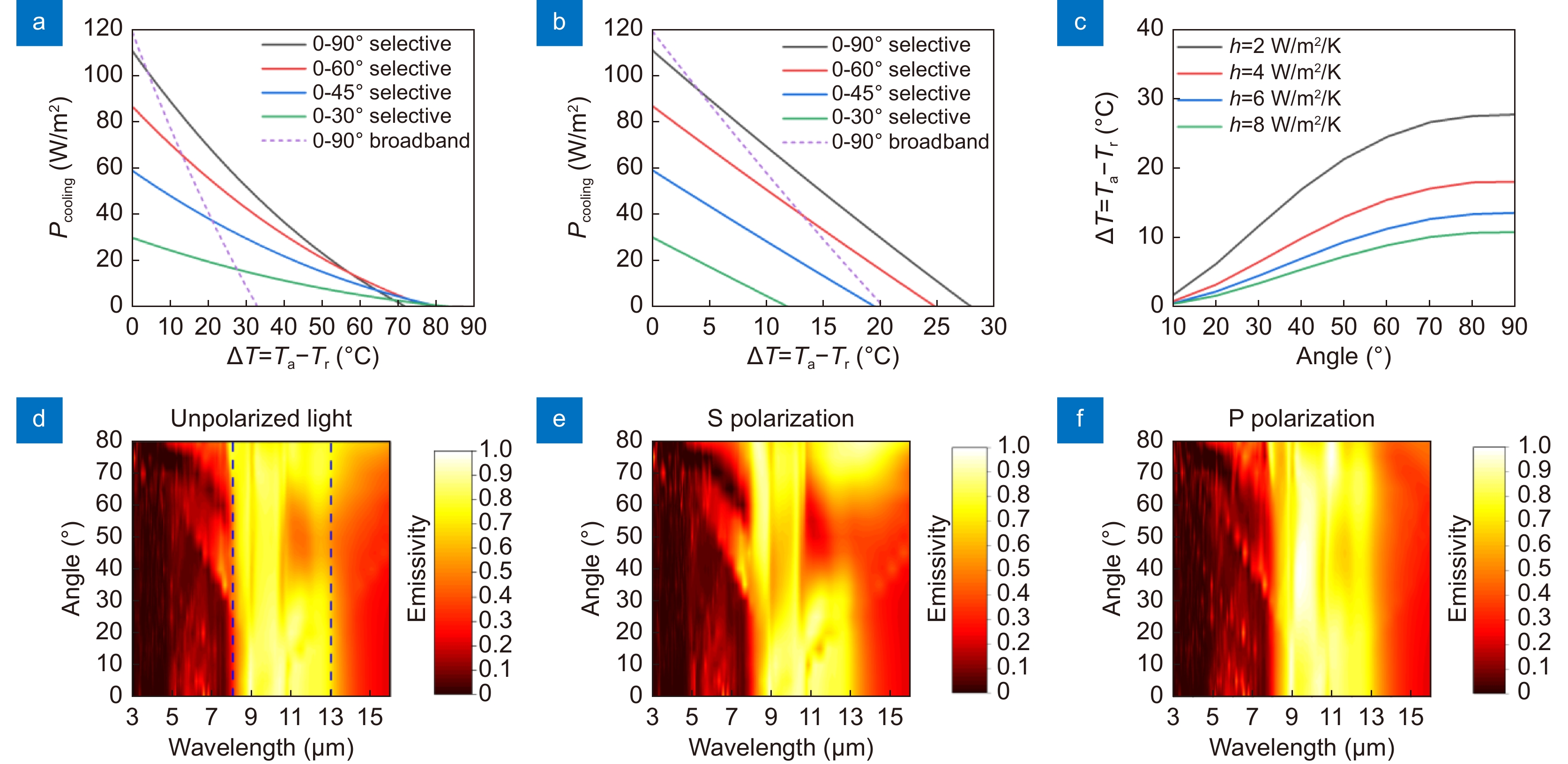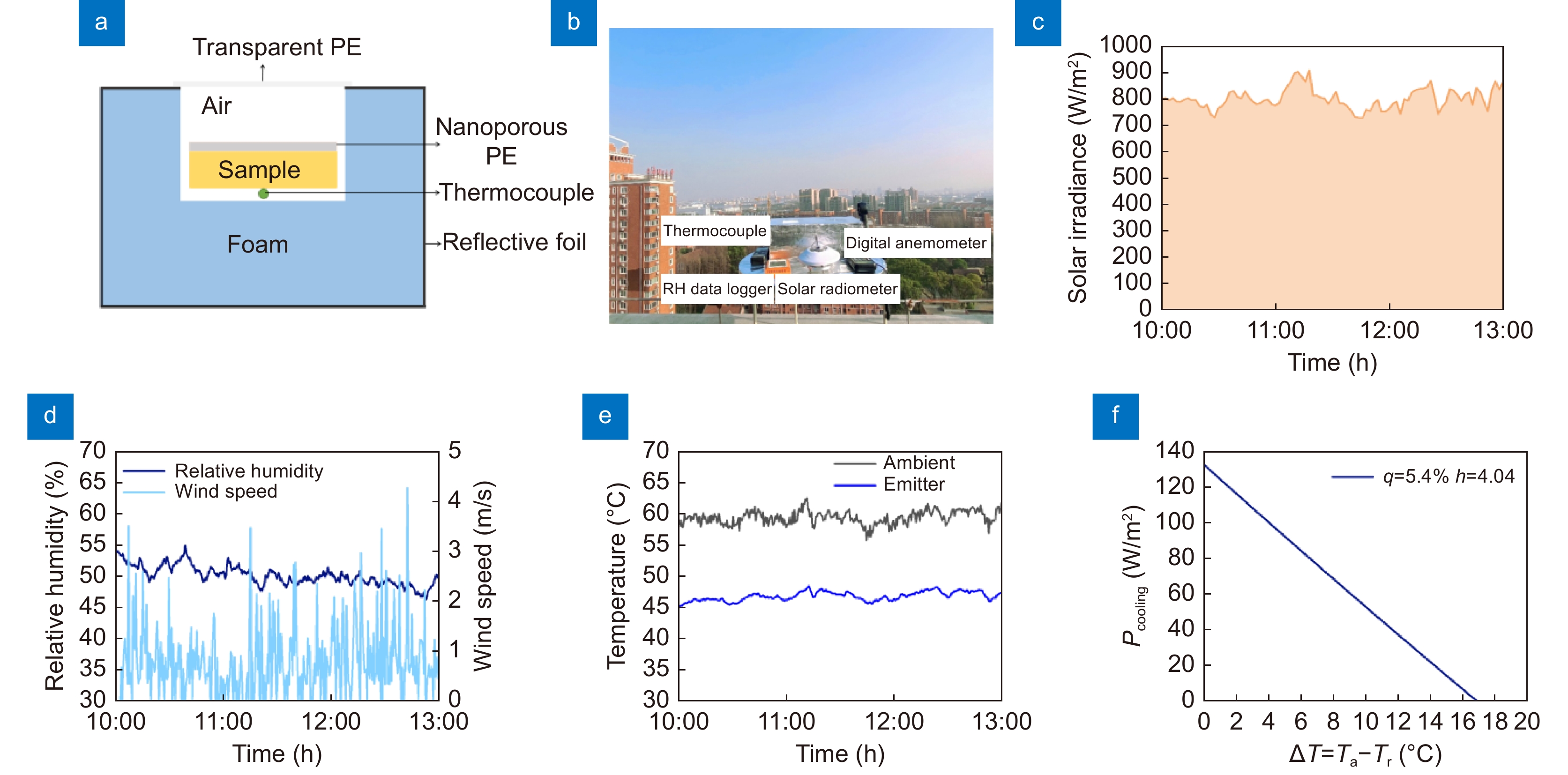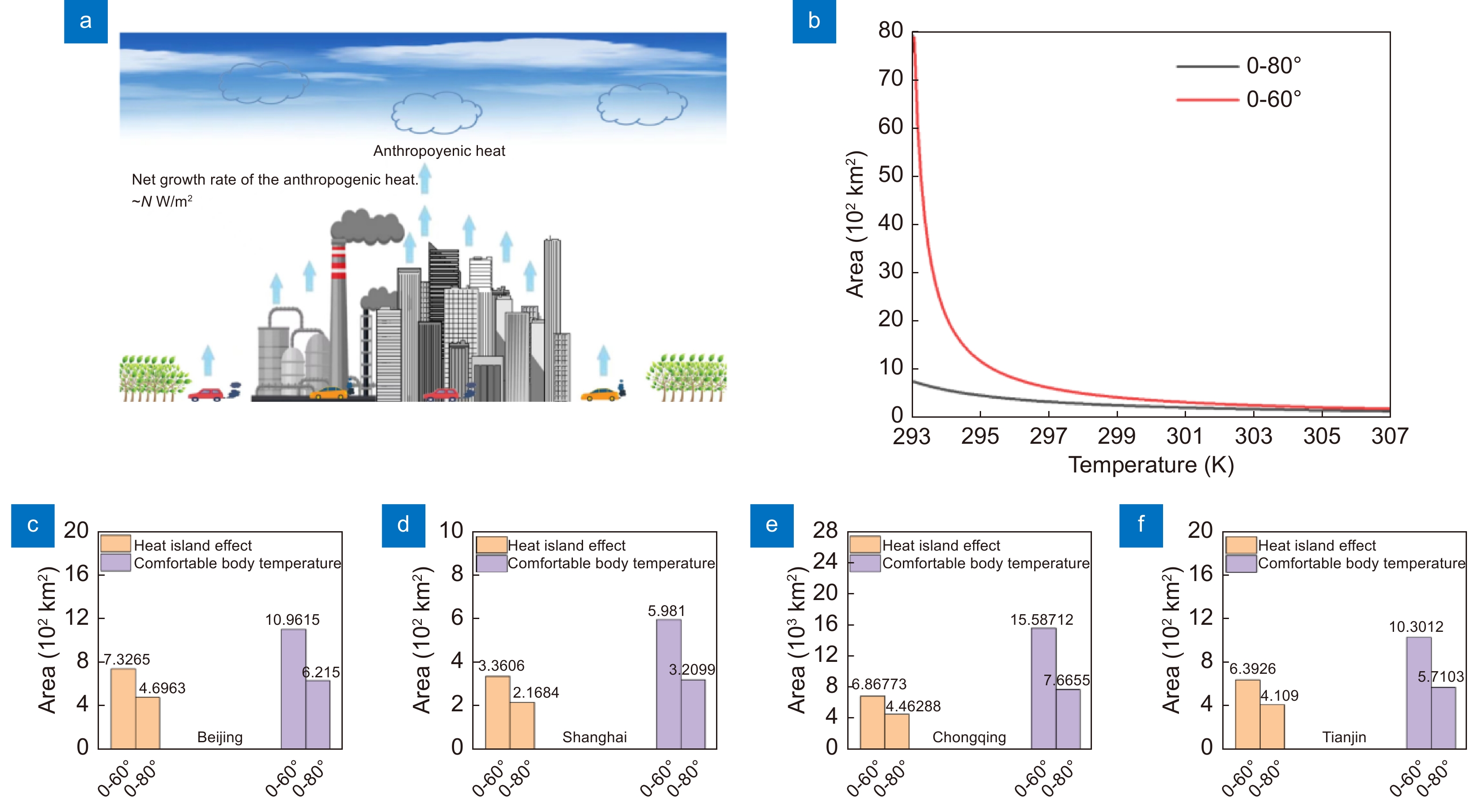-
Abstract
Real-world passive radiative cooling requires highly emissive, selective, and omnidirectional thermal emitters to maintain the radiative cooler at a certain temperature below the ambient temperature while maximizing the net cooling power. Despite various selective thermal emitters have been demonstrated, it is still challenging to achieve these conditions simultaneously because of the extreme difficulty in controlling thermal emission of photonic structures in multidimension. Here we demonstrated hybrid polar dielectric metasurface thermal emitters with machine learning inverse design, enabling a high emissivity of ~0.92 within the atmospheric transparency window 8–13 μm, a large spectral selectivity of ~1.8 and a wide emission angle up to 80 degrees, simultaneously. This selective and omnidirectional thermal emitter has led to a new record of temperature reduction as large as ~15.4 °C under strong solar irradiation of ~800 W/m2, significantly surpassing the state-of-the-art results. The designed structures also show great potential in tackling the urban heat island effect, with modelling results suggesting a large energy saving and deployment area reduction. This research will make significant impact on passive radiative cooling, thermal energy photonics and tackling global climate change.
Keywords
-
Introduction
Ideal selective thermal emitters with a unity emissivity in the atmospheric transparency window 8–13 μm and zero emissivity outside the window are highly demanded as they suppress the absorption from downward atmosphere thermal emission outside the transparency window, allowing much lower equilibrium temperature2, 37. Although it has been previously demonstrated by a few simple and well-established photonic structures, including multilayer dielectric thin films1, 14-17, silica sphere/polymer metamaterials11-13, plasmonic metasurfaces/nanoparticles19-21, 38, which utilize photonic resonances to enhance their infrared emission, the emission profiles of these structures are still highly dispersive with either low emissivity or mismatched with the transparency window. To achieve ideal selective thermal emissions, complex photonic structures with multiple geometry degrees of freedom and multiple photonic resonances and resonance couplings are highly required to mitigate the intrinsically highly dispersive emission nature of single photonic material.
The accelerated global warming and environmental threats on human life have motivated enormous research and development on zero-carbon cooling technologies to replace or complement the conventional compressed air-based cooling technologies. Daytime passive radiative cooling is a recently demonstrated disruptive technology that could potentially transform the global energy landscape because of its zero-energy consumption and zero-carbon emission1-7. The success of this technology replies on the spectral control over both the solar and thermal wavelengths by advanced photonic structures and micro/nano-fabrication technologies that enable simultaneous reflection of strong solar irradiation and radiation of heat to the ultracold outer space5, 6, 8-36.
To tackle the aforementioned challenges, we propose hybrid metasurface thermal emitters consisting of polar dielectric materials for highly selective, strongly emissive, and omnidirectional thermal emission. Hybrid metasurfaces are engineered planar photonic structures with complex building blocks featuring multiple physical degrees of freedom and photonic resonances39-42, holding great promise in controlling the thermal emission dispersion. By designing and optimizing the geometry-dependent multiple Mie resonances by machine learning inverse design, we demonstrated thermal emitters with an emissivity of ~0.92 across the atmospheric transparency window, ultra-high spectral selectivity of ~1.8 and emission angle up to 80 degrees simultaneously, leading to a new record of equilibrium temperature reduction as large as ~15.4 °C in rooftop test, significantly surpassing the state-of-the-art radiative coolers under non-vacuum conditions. The demonstrated radiative cooler also holds great promise for the urban heat island effect mitigation with modeling results suggesting a more than 50% deployment area reduction compared with the current radiative coolers.
On the other hand, the angular profile of the emissivity determines both the lowest steady temperature and the cooling power. In practical scenarios, maintaining the radiative coolers below the ambient temperature while maximizing the net cooling power is of critical importance because the radiative coolers exchange significant heat with surrounding environment through the non-radiative heat conductive and convection processes, such as the heat conduction by physically contacting with the experimental apparatus or the targeted cooling objects4. To achieve this, one needs to balance these external heating loads by widening the thermal emission angle in addition to the spectrally selective bandwidth, i.e., achieve selective and omnidirectional thermal emitters. However, very few studies have paid attention to this nontrivial emission angle issue, let alone achieving highly selective and omnidirectional thermal emission, simultaneously.
Results and discussion
Design of hybrid polar dielectric metasurface thermal emitters
To optimize this complex hybrid metasurfaces with multiple degrees of freedom, we employed artificial neuron network inverse design method (Fig. 1(c)), which allows effectively and time-efficiently inverse designing photonic structures with targeted optical responses43-47. Firstly, the neuron network is trained to forwardly predict the thermal emission spectra from a given set of structure parameters by the sample data obtained from the finite difference time domain calculations. Then the weights of the neuron network are fixed, and the back propagation method is used to optimize the input structure parameters to find the geometry that can mostly produce the ideal selective thermal emission. The training error graphed in Fig. S1(a) and cross-validation responses for various layer configurations in Table S1 confirm that the neuron network is well established and trained. Furthermore, the tested forward structure-spectra prediction and inverse spectra-structure design shown in Fig. S1(b, c) demonstrated the accuracy of the network in approximating the simulation and optimizing the structure. Metasurface thermal emitters with different layer numbers (2, 3 & 4) are optimized, demonstrating highly emissive and selective thermal emissions in all cases (Fig. S2). Interestingly, even a 2-layer configuration can achieve excellent selective thermal emission, greatly easing the practical fabrication complexity. The optimized selective thermal emission spectra for a 3-layer structure are shown in Fig. 1(d), suggesting an average thermal emissivity of ~0.92 across the atmospheric transparency window 8–13 μm and a spectral selectivity of ~1.8 (see Supplementary information for the definition). More exhilaratingly, the high emissivity and selectivity was found to remain unchanged within an emission angle up to 80 degrees. This is so far the first thermal emitter with simultaneously high emissivity, high selectivity, and large emission angle to the best of our knowledge (Fig. 1(e)).
![Figure 1. Design of hybrid polar dielectric metasurface thermal emitter. (a) The proposed hybrid metasurface with the unit consisting of alternating Si3N4 and SiO2 polar dielectric materials. Patm is the downward atmosphere thermal emission and Prad is the thermal emission of the metasurfaces. (b) The normalized scattering cross-section of the optimized 3-layer (SiO2/Si3N4/SiO2) Mie resonator with the electrical field distributions at various resonance wavelengths and the extinction coefficients of Si3N4 (red) and SiO2 (green). (c) Schematic of the multilayer perception neural network for inverse design with input, hidden and output layers. (d) Emissivity spectrum of the inversely optimized 3-layer selective thermal emitter, compared with the ideal spectrum. (e) Emissivity, selectivity, and emission angle of this work, in comparison with state-of-the-art results.]()
Design of hybrid polar dielectric metasurface thermal emitter. (a) The proposed hybrid metasurface with the unit consisting of alternating Si3N4 and SiO2 polar dielectric materials. Patm is the downward atmosphere thermal emission and Prad is the thermal emission of the metasurfaces. (b) The normalized scattering cross-section of the optimized 3-layer (SiO2/Si3N4/SiO2) Mie resonator with the electrical field distributions at various resonance wavelengths and the extinction coefficients of Si3N4 (red) and SiO2 (green). (c) Schematic of the multilayer perception neural network for inverse design with input, hidden and output layers. (d) Emissivity spectrum of the inversely optimized 3-layer selective thermal emitter, compared with the ideal spectrum. (e) Emissivity, selectivity, and emission angle of this work, in comparison with state-of-the-art results.
The hybrid dielectric metasurface structure is shown in Fig. 1(a), where the unit of the metasurface consists of alternating SiO2 and Si3N4 micro-disks, forming a hybrid dielectric Mie resonator, which is mainly responsible for enhancing the thermal emission. The bottom layer of the structure is an optically thick Ag back reflector, which can reflect the incoming solar irradiation and enhance the light-mater interactions at the thermal wavelengths. The constituted material of the metasurface unit can also be other polar dielectric materials such as Al2O3, TiO2, HfO2 with phonon polariton resonances within the transparency window. In such a structure, multiple Mie resonances can be excited to control the thermal emission dispersion in the infrared wavelength. Figure 1(b) illustrates the normalized scattering cross-section of an optimized SiO2/Si3N4/SiO2 3-layer geometry, along with the electric field distributions at the resonance wavelengths. Notably, Mie resonances of different orders at the wavelengths of 9, 10.2 and 12.9 μm are observed, in addition to the phonon polariton resonances at the wavelengths of 9.3 μm and 11.5 μm. Some of the resonances within the structure might interfere with each other forming a hybridized electric field distribution because of the geometrical contact between SiO2 and Si3N4 layers.
The fabricated thermal emitter and infrared emissivity
To experimentally demonstrate the high performance selective thermal emission, the optimized 2-layer hybrid metasurfaces are fabricated on top of a 4 inches silicon wafer with the bottom side coated with an optically thick Ag mirror, with Fig. 2(a) showing a photography of the fabricated sample (see Methods for details of the fabrication procedures). Figure 2(b) shows the top-view and tilted scanning electron microscope (SEM) images of an array of the hybrid SiO2/Si3N4 dielectric resonators, demonstrating a uniform 2D array and clear 2-layer structures. The measured diameter and periodicity of the structures are 4.22 μm and 9.15 μm, respectively. While the thickness of the SiO2 and Si3N4 are 6.2 μm and 1.4 μm. The energy-dispersive X-ray spectroscopy elemental mappings of Si, O and N in Fig. 2(c) confirms the constitute material of the structure. Particularly, the element of N and O are observed on the top and bottom layer of the structures, respectively, indicating the top Si3N4 and bottom SiO2 materials. We measured the emissivity spectra of the structure via Fourier-transform infrared (FTIR) spectroscopy with an unpolarized incident light beam, with the results shown in Fig. 2(d). Clearly, the structure exhibits high-emissivity and high-selectivity emission profile, agreeing very well with the theoretically optimized results in Fig. S2(a). The difference between the experimental and theoretical results are due to the imperfect fabrication and the minor dielectric constant difference. The measured average emissivity can achieve ~0.92 in the transparency window and ~0.6 among the entire range 3–16 μm, with a spectral selectivity of ~1.53. The relative smooth emission profiles in the transparency window are attributed to the multipolar Mie resonances and the material intrinsic absorption properties. To further reveal this, we performed a multipolar decomposition of the 2-layer dielectric Mie resonator. Two feature peaks at 8.9 μm and 10.5 μm appear in the spectrum, corresponding to the electric and magnetic dipole resonances, respectively. The electric and magnetic field profiles further confirm the magnetic and electric dipole resonances. The resonance enhances the electric field at the wavelengths where the material absorption is relatively weak and accordingly increase the total absorption/emission. For example, the electric field at the wavelength of 10.5 μm mainly concentrates at the bottom SiO2 layer, enhancing the absorption/emission of SiO2 at this wavelength.
![Figure 2. The fabricated 2-layer metasurface and its emissivity. (a) A photography of the fabricated 4 inches metasurface thermal emitter. (b) Top-view and tilted SEM images of an array of the hybrid SiO2/Si3N4 dielectric resonators (scale bar: 10 μm and 2 μm for the left and right two figures, respectively). (c) Energy-dispersive X-ray spectroscopy elemental mappings of the metasurfaces (scale bar: 5 μm). (d) The measured infrared emissivity of the metasurfaces. (e) Multipolar decomposition of the 2-layer dielectric resonator. ED: electrical dipole; MD: magnetic dipole; EQ: electric quadrupole; MQ: magnetic quadrupole. (f) Electric and magnetic field profiles at the two resonance wavelengths 8.9 μm (top) and 10.5 μm (bottom).]()
The fabricated 2-layer metasurface and its emissivity. (a) A photography of the fabricated 4 inches metasurface thermal emitter. (b) Top-view and tilted SEM images of an array of the hybrid SiO2/Si3N4 dielectric resonators (scale bar: 10 μm and 2 μm for the left and right two figures, respectively). (c) Energy-dispersive X-ray spectroscopy elemental mappings of the metasurfaces (scale bar: 5 μm). (d) The measured infrared emissivity of the metasurfaces. (e) Multipolar decomposition of the 2-layer dielectric resonator. ED: electrical dipole; MD: magnetic dipole; EQ: electric quadrupole; MQ: magnetic quadrupole. (f) Electric and magnetic field profiles at the two resonance wavelengths 8.9 μm (top) and 10.5 μm (bottom).
Angle-resolved thermal emission
Our selective thermal emitters show surprisingly high-performance omnidirectional emission properties, with the unpolarized emissivity under different angles shown in Fig. 3(d). The selectivity can even preserve at an angle up to 80 degrees without obvious emission reduction across the transparency window, except a minor reduction within 40–60 degrees. This can be attributed to the relatively weak absorption/emission of s polarized light at the wavelengths of 11–13 μm (Fig. 3(e)) because of the reduced electric field distribution. Nevertheless, this does not influence the average thermal emission too much because of the highly emissive and selective spectral profile of the p polarized thermal emission (Fig. 3(f)).
Apart from the spectral domain, the emission profile in angular domain also plays crucial roles. Generally, angular selective thermal emitter with an emission angle restricted in the zenith direction is believed to allow much lower equilibrium temperature because it avoids the oblique thermal radiation from the atmosphere. Indeed, the calculated net cooling power (Fig. 3(a)) of the radiative cooler under zero solar absorption and zero non-radiative heat exchange, indicating an optimum emission angle in the zenith direction for lower steady temperature (see Supplementary information on the detailed calculations). However, the real-world scenarios and applications involves unavoidable non-radiative heat exchange, i.e., heat conduction and convection, requiring larger cooling power to balance these external heating loads and might pose different angular constraints. Therefore, the emissivity profile needs to be reconsidered and reanalyzed in real-world applications. A theoretical calculation of the cooling power as a function of the temperature considering the non-radiative heat exchange (h=2 W/m2/K) was performed with the results shown in Fig. 3(b). It is demonstrated that wide-angle selective thermal emitter enables larger cooling power and lower equilibrium temperature as well under realistic conditions even with a small heat exchange coefficient of 2 W/m2/K (approximately the lowest value for non-vacuum apparatus). The steady temperature was also calculated with various emission angles under different non-radiative heat exchange coefficients (Fig. 3(c)), confirming the superiority of selective and omnidirectional thermal emitters in achieving lower steady temperature in practical scenarios.
![Figure 3. Angle-resolved thermal emissivity. (a, b) Net cooling power Pcooling of the ideal selective thermal emitter with various thermal emission angles in the cases of heat exchange coefficient h = 0 W/m2/K (a) and 2 W/m2/K (b). Ta and Tr are ambient and radiative cooler temperature, respectively. (c) The steady temperature of the radiative cooler as a function of the emission angle for various heat exchange coefficients h. (d–f) The angle-resolved emissivity (unpolarized, s polarized, and p polarized) of the metasurface thermal emitter.]()
Angle-resolved thermal emissivity. (a, b) Net cooling power
Pcooling of the ideal selective thermal emitter with various thermal emission angles in the cases of heat exchange coefficient h = 0 W/m2/K (a) and 2 W/m2/K (b). Ta and Tr are ambient and radiative cooler temperature, respectively. (c) The steady temperature of the radiative cooler as a function of the emission angle for various heat exchange coefficients h. (d–f) The angle-resolved emissivity (unpolarized, s polarized, and p polarized) of the metasurface thermal emitter. Cooling performance of the radiative cooler
![Figure 4. (a) Schematic of the apparatus and the metasurface radiative cooler. (b) Photo of the apparatus on the test rooftop in Shanghai, China. (c, d) The solar irradiation and environment (wind speed and relative humidity) during the rooftop test. (e) Steady-state temperature of the metasurface radiative cooler and the ambient temperature. (f) The net cooling power of the radiative cooler using the experimental spectra data (solar absorbance: q=5.4%; heat exchange coefficient: h=4.04 W/m2/K).]()
(a) Schematic of the apparatus and the metasurface radiative cooler. (b) Photo of the apparatus on the test rooftop in Shanghai, China. (c, d) The solar irradiation and environment (wind speed and relative humidity) during the rooftop test. (e) Steady-state temperature of the metasurface radiative cooler and the ambient temperature. (f) The net cooling power of the radiative cooler using the experimental spectra data (solar absorbance: q=5.4%; heat exchange coefficient: h=4.04 W/m2/K).
To experimentally test the radiative cooling performance of the selective and omnidirectional thermal emitters, a continuous outdoor measurement of the temperature was performed on clear days in Shanghai, China. The schematic diagram of the outdoor apparatus is shown in Fig. 4(a), where the sample is placed inside a foam with low thermal conductivity to minimize the non-radiative heat exchange. Al foil was used to wrap the foam such that the solar irradiation and surrounding thermal emission is reflected to avoid heating up the foam. On top of the setup, an IR transparent low-density polyethylene (PE) film was used to seal the sample preventing wind effect during the measurement and the thermal couple that tests the ambient temperature is located inside the enclosed box of the apparatus. To increase the solar reflection, a home-made nanoporous PE film was integrated on top of the sample. Figure 4(b) presents a real photo of the apparatus, where the pyranometer, the thermocouple, wind and humidity monitors are included. The solar reflection spectra of the nanoporous PE film and its infrared transmission are shown in Fig. S3, respectively. The integrated device shows high solar reflection across the entire solar wavelength range 0.3–2.5 μm, with an average solar reflectivity of ~95%. We performed the test on both winter and summer days. On the winter day, an average temperature reduction of 10 °C was realized, with a maximum temperature reduction of 14.7 °C when the sample was exposed to a solar irradiation of 600–650 W/m2 at noon time (Fig. S4). On the summer day, a higher average temperature reduction of 12.7 °C with maximum reduction of 15.4 °C was demonstrated even the sample was exposed to much stronger solar irradiation of 800–850 W/m2 (Fig. 4(c–e)). The demonstrated experimental results are obviously superior to state-of-the-art results (Table S2). Considering the potential improvement room of the solar reflection, the temperature reduction can be further expected. To further elucidate the cooling performance of the fabricated thermal emitter, we calculated the cooling power as a function of the temperature reduction using the experimental measured solar and emission spectra. The solar intensity and wind speed are 804 W/m2 and 0.77 m/s, respectively, corresponding to the data at the maximum cooling performance of 15.4 °C. The heat exchange coefficient between the thermal emitter and the surrounding environment was calculated by the equation h=2.5+2v, where v is the measured wind speed48. It is revealed the experimental maximum temperature reduction is close to the theoretical maximum value 16.5 °C, demonstrating excellent performance of our metasurface radiative coolers.
Urban heat island effect mitigation
![Figure 5. (a) Schematic diagram of the urban heat island effect. The ~N W/m2 represents the net growth rate of the anthropogenic heat. (b) The calculated deployment area to reduce the temperature by our metasurface radiative cooler with emission angle of 80° and 60°, respectively. (c–f) The calculated area for eliminating the heat island effect and achieving a comfortable body temperature during summertime for China’s four big cities: Beijing, Shanghai, Chongqing, and Tianjin.]()
(a) Schematic diagram of the urban heat island effect. The ~N W/m2 represents the net growth rate of the anthropogenic heat. (b) The calculated deployment area to reduce the temperature by our metasurface radiative cooler with emission angle of 80° and 60°, respectively. (c–f) The calculated area for eliminating the heat island effect and achieving a comfortable body temperature during summertime for China’s four big cities: Beijing, Shanghai, Chongqing, and Tianjin.
The demonstrated selective and omnidirectional thermal emitters allow both lower steady temperature and larger cooling power, which is of critical importance for many practical cooling applications with nontrivial external heating load, such as the urban heat island effect. The urbanized areas usually experience higher temperatures up to 6 °C than outlying areas because of the net heat gain in the city areas49. Therefore, deploying radiative coolers in city areas can offset this net heat gain thereby preventing or even eliminating the urban heat island effect (Fig. 5(a)). The potential energy savings and deployment areas can be calculated. Figure S5 shows the cooling power of our radiative cooler when exposed to an ambient temperature of 307 K (average summer temperature of Shanghai, China50) under various angle restriction using the simulated emission spectra. The required area for eliminating the net heat gain by using our wide-angle radiative cooler can be calculated (Fig. 5(b)). As can be seen, the deployment area by using our radiative cooler is significantly lower than that by current reported radiative coolers with an emission angle of ~60 degree. The area required to eliminate the urban heat island effect in typical summertime for 4 big cities in China: Beijing, Shanghai, Chongqing, Tianjin was further calculated using the reported net heat gain data (Fig. 5(c–f))51. The results demonstrate that our wide-angle radiative cooler significantly reduce the deployment area by 35%. Furthermore, when reducing the temperature to a comfortable body temperature of 24 °C, the deployment area can be reduced by more than 50%. With the development of scalable manufacturing technologies of metasurfaces and improved designs, it is believed the selective and omnidirectional thermal emitters will bring broad and significant impact on relieving the urban heat island effect and other global warming issues.
Conclusions
We have demonstrated a highly emissive and selective omnidirectional thermal emitter for passive radiative cooling by hybrid polar dielectric metasurfaces mediated by machine learning. This enables simultaneously lower steady temperature and larger cooling power, significantly favoring the practical applications of radiative coolers, where non-radiative heat exchange is nontrivial. The experimental cooling performance breaks through the current state-of-the-art temperature reduction under similar conditions, with a record-high temperature reduction of ~15.4 °C. This research will open up new pathway and possibility to access the limitation of radiative cooling technology by using complex photonic structure assisted with machine learning inverse design.
Methods
Structure characterization. The scanning electron microscope (Zeiss Gemini SEM 300) was used to observe morphologies of the metasurfaces and the distribution of elements in the hybrid elastomer was examined by energy dispersive spectroscope (EDS) conducted on SEM. The optical reflectance of thermal emitter in the ultraviolet, visible and near-infrared (0.3–2.5 μm) wavelength ranges were separately measured using an ultraviolet-visible-near-infrared (UV-Vis-NIR) spectrophotometer (Hitachi, U-4100, Japan) equipped with a deuterium lamp for UV region, tungsten-halogen lamp for Vis, NIR range and a polytetrafluoroethylene integrating sphere. The thermal emission spectra in the mid-infrared wavelength ranges (3–16 μm) were characterized in an FTIR spectrometer (INVENIOR, Bruker) equipped with a deuterated triglycine sulfate crystal detector RT-DTGS, a gold integrating sphereA562 Integrating Sphere, Bruker and KBr beam splitter.
Solar reflector fabrication. The porous PE films were fabricated via phase-inversion-based method. In brief, PE powder, paraffin oil, butylated hydroxyto-luene and other additives were stirred at 150 °C for 3 h to produce a homogenous solution. The heated solution was pushed through a sheet die to make a gel-like film and stretched uniaxially. The as-formed gel was extracted with cyclohexane several times and dried to obtain the porous PE films.
Rooftop test. The radiative cooling performance of the sample was tested in January 12th and July 6th 2022 in Shanghai (East Coast of China, 31°18'22" N, 121°30'17" E) under a clear sky. A thermal box was designed with insulation foam covered by a layer of reflective foil, while transparent PE was used to seal the upper part to minimize conduction and convective heat exchange. A relative humidity (RH) data logger (GSP-8, Elitech Corp, China) with an accuracy of ±0.1% RH was placed near the thermal box to measure the relative air humidity. A thermocouple (SA1-T-72) temperature detector was mounted on the back of the sample to measure the real-time temperature, and another thermocouple was placed in internal air of the same thermal box (without the sample) to measure the ambient temperature. The solar irradiation incidence on the samples was measured by solar radiometer with an accuracy of ±0.3% (MS-410, EKO). Two thermocouples, the solar radiometer, were connected to the data recorder (OM-CP-OCTPRO, OMEGA) to record the data. The wind speed around our thermal boxes was measured using a digital anemometer with an accuracy of ±2.5% (AS856, Smart Sensor Corp, China). Wind speed and temperature were automatically tracked every 30 seconds, solar illumination was recorded every 10 minutes, and humidity was recorded every 10 seconds.
Thermal emitter fabrication. A Si wafer was firstly cleaned by acetone, isopropanol, and deionized water. Then, plasmon enhanced chemical vapor deposition system was used to deposit the SiO2 and Si3N4 on top of the Si wafer. A pre-designed hard mask layer was fabricated by sputtering nickel on top of the dielectric layer followed by the standard photolithography and ion beam etching. Then dry etching was employed to etch the SiO2 and Si3N4 layer. After this, the nickel mask layer was removed by chemical reactions. At last, an optically thick silver layer was sputtered at the back side of the Si wafer with an adhesion layer of Ti.
Acknowledgements
This work was supported by the National Natural Science Foundation of China (NSFC) (Grant No. 62175154), the Shanghai Pujiang Program (20PJ1411900), the Shanghai Science and Technology Program (21ZR1445500), the Shanghai Yangfan Program (22YF1430200) and the Program for Professor of Special Appointment (Eastern Scholar) at Shanghai Institutions of Higher Learning.
Competing interests
The authors declare no competing financial interests.
-
References
[1] Raman AP, Anoma MA, Zhu LX et al. Passive radiative cooling below ambient air temperature under direct sunlight. Nature 515, 540–544 (2014).
DOI: 10.1038/nature13883[2] Zhang YN, Chen X, Cai BY et al. Photonics empowered passive radiative cooling. Adv Photon Res 2, 2000106 (2021).
DOI: 10.1002/adpr.202000106[3] Yin XB, Yang RG, Tan G et al. Terrestrial radiative cooling: using the cold universe as a renewable and sustainable energy source. Science 370, 786–791 (2020).
DOI: 10.1126/science.abb0971[4] Fan SH, Li W. Photonics and thermodynamics concepts in radiative cooling. Nat Photonics 16, 182–190 (2022).
DOI: 10.1038/s41566-021-00921-9[5] Li T, Zhai Y, He SM et al. A radiative cooling structural material. Science 364, 760–763 (2019).
DOI: 10.1126/science.aau9101[6] Zeng SN, Pian SJ, Su MY et al. Hierarchical-morphology metafabric for scalable passive daytime radiative cooling. Science 373, 692–696 (2021).
DOI: 10.1126/science.abi5484View full references list -
Cited by
Periodical cited type(50)
1. Nousios, G., Algorri, J.F., Fuscaldo, W. et al. Silicon slot metasurface supporting a multitude of bound states in the continuum: theoretical and experimental studies. Optics and Laser Technology, 2025. DOI:10.1016/j.optlastec.2025.113398 2. Xu, J., Yang, Y., Zheng, Z. et al. Non-diffracted Airy beams based on multi-layer transmissive metasurface. Optics and Laser Technology, 2025. DOI:10.1016/j.optlastec.2025.113388 3. Chen, X., Qin, L., Huang, J. et al. Controlling thermal radiation by metasurface for infrared and laser compatible stealth with radiative cooling. Optics and Laser Technology, 2025. DOI:10.1016/j.optlastec.2025.113017 4. Shi, F., Feng, H., Gu, M. et al. Review for holography display enabled by metasurfaces in the ultraviolet to terahertz wavelength bands. Optics and Lasers in Engineering, 2025. DOI:10.1016/j.optlaseng.2025.109191 5. Zhu, S., Deng, X.-H., Liu, Y. et al. Reconfigurable terahertz metasurface and dynamic vortex beam manipulation based on the phase transition characteristics of VO2. Physics Letters Section A General Atomic and Solid State Physics, 2025. DOI:10.1016/j.physleta.2025.130776 6. Xiang, X., Liu, P., Peng, Y. et al. Scalable and sustainable sandwich-structured colorful fabric for passive color-preserving thermal management. Chemical Engineering Journal, 2025. DOI:10.1016/j.cej.2025.165702 7. Ning, X., Sun, T., Song, Q. et al. A modulated broadband polarimetric insensitive metamaterial absorber based on a monolayer of graphene. Communications in Theoretical Physics, 2025, 77(9): 095702. DOI:10.1088/1572-9494/adbf80 8. Eom, H., Lee, J., Kim, J. et al. Scalable and tunable micro/nanostructuring of aluminum surfaces via chemical etching for enhanced heat dissipation. Applied Thermal Engineering, 2025. DOI:10.1016/j.applthermaleng.2025.126729 9. Feng, G., Tao, Y., Zheng, M. et al. Reflective Tunable Coded Metalens Based on Phase Change Materials. Journal of Electronic Materials, 2025, 54(8): 6768-6779. DOI:10.1007/s11664-025-12095-z 10. Cheng, H., Yang, Y., Gu, M. et al. Real-time holographic imaging programmable metasurfaces based on hardware accelerator computation. Precision Engineering, 2025. DOI:10.1016/j.precisioneng.2025.05.004 11. Ali, R., Su, W., Ali, M. et al. High-performance metasurface based daytime radiative cooler designed by random forest method. Solar Energy Materials and Solar Cells, 2025. DOI:10.1016/j.solmat.2025.113591 12. Chen, L., Su, Z., Gu, M. et al. Review of Terahertz Perfect Vortex Field Based on Metasurface. International Journal of Theoretical Physics, 2025, 64(7): 185. DOI:10.1007/s10773-025-06015-4 13. Kang, J., Lee, C., Chung, H. et al. Design strategies, manufacturing, and applications of radiative cooling technologies. Nanophotonics, 2025, 14(14): 2355-2395. DOI:10.1515/nanoph-2025-0159 14. Zhang, R., Wang, Y., Chen, Y. et al. Triband Glazing for Simultaneous Year-Round Energy Savings and Anticondensations. ACS Applied Energy Materials, 2025, 8(11): 7413-7423. DOI:10.1021/acsaem.5c00787 15. Yu, H., Chen, A., Li, M. et al. Performance analysis of porous solar absorbers with high-temperature radiation cooling function. Chinese Physics B, 2025, 34(6): 068102. DOI:10.1088/1674-1056/add4e3 16. Shi, Y., Zhu, A., Li, Q. et al. Inverse design of visible-infrared multispectral camouflage with radiative cooling and microwave transmission. Materials Today Physics, 2025. DOI:10.1016/j.mtphys.2025.101759 17. Tao, Y., Qiu, X., Liu, F. et al. Convolutional neural network for coded metasurface inverse design. Applied Physics B Lasers and Optics, 2025, 131(6): 118. DOI:10.1007/s00340-025-08475-2 18. Li, T., Liu, Y., Xing, L. et al. Improved Optical Signal Processing with On-Chip Programmable Filter. Photonics, 2025, 12(5): 416. DOI:10.3390/photonics12050416 19. Zhao, Y., Li, J., Liu, Y. et al. Strong Coupling Based on Quasibound States in the Continuum of Nanograting Metasurfaces in Near-Infrared Region. Photonics, 2025, 12(5): 508. DOI:10.3390/photonics12050508 20. Liu, F., Li, Y., Tao, Y. et al. Large-angle directional scattering of terahertz beams based on all-dielectric metasurface. European Physical Journal D, 2025, 79(5): 45. DOI:10.1140/epjd/s10053-025-00998-9 21. Ye, H., Jin, Y., Huang, W. et al. Review for metamaterial-based energy harvester and absorber. EPJ Applied Physics, 2025. DOI:10.1051/epjap/2025015 22. Liu, B., Zhang, R., Yu, T. et al. Ultrabreathable Open-Cell Hierarchical Pore Structure for Radiative Cooling Protective Membranes. ACS Applied Materials and Interfaces, 2025, 17(17): 25663-25673. DOI:10.1021/acsami.5c01129 23. Li, M., Huang, X., Wu, B. et al. Photolithography-free switchable broadband thermal emitter based on In3SbTe2 for radiative thermal management. Optics Continuum, 2025, 4(4): 713-721. DOI:10.1364/OPTCON.554500 24. Wu, Y., Liu, B., Zhang, R. et al. Eco-Friendly and Scalable Preparation of High-Efficiency Passive Daytime Radiative Cooling Film Based on Dual-Layer Strategy. Advanced Optical Materials, 2025, 13(11): 2403087. DOI:10.1002/adom.202403087 25. Thiyagarajan, D., Li, S., Lee, B.-K. Fibrous Sphere Architectures for Efficient Daytime Radiative Cooling and Moisture Management. Nano Letters, 2025, 25(14): 5609-5615. DOI:10.1021/acs.nanolett.4c06020 26. Tong, Y., Qiu, X., Lou, B. et al. Design and Analysis of Terahertz Wave All-Dielectric Grating Magnetic Reflector. Journal of Electronic Materials, 2025, 54(4): 3206-3216. DOI:10.1007/s11664-025-11818-6 27. Zheng, S., Gu, M., Feng, G. et al. Design of a Polarization-Insensitive and Wide-Angle Triple-Band Metamaterial Absorber. Photonics, 2025, 12(4): 386. DOI:10.3390/photonics12040386 28. Niu, S., Ren, Z., Wang, C. et al. Machine learning-assisted structure design and materials screening of a bilayer thin-film selective thermal emitter for infrared stealth technology. Chemical Engineering Journal, 2025. DOI:10.1016/j.cej.2025.161418 29. Wang, K., Sun, K., Ding, Q. et al. High-Q Resonance Engineering in Momentum Space for Highly Coherent and Rainbow-Free Thermal Emission. Nano Letters, 2025, 25(9): 3613-3619. DOI:10.1021/acs.nanolett.4c06565 30. Yuan, H., Zeng, Q., Wang, Z. et al. Ultra-Broadband solar absorber and Near-Perfect thermal emitter based on columnar titanium micro-structure. Applied Thermal Engineering, 2025. DOI:10.1016/j.applthermaleng.2024.125294 31. Li, Z., Han, H., Chao, L. et al. Recent Advances of AgBiS2: Synthesis Methods, Photovoltaic Device, Photodetector, and Sensors. Electromagnetic Science, 2025, 3(1): 0090451. DOI:10.23919/emsci.2024.0045 32. Li, Z., Cheng, S., Zhang, H. et al. Ultrathin broadband terahertz metamaterial based on single-layer nested patterned graphene. Physics Letters Section A General Atomic and Solid State Physics, 2025. DOI:10.1016/j.physleta.2025.130262 33. Tan, R., Li, Y., Bai, G. et al. Integration of Radiative Cooling and Solar Heating in Thermal Management Films for Year-Round Energy Savings. ACS Sustainable Chemistry and Engineering, 2025, 13(6): 2604-2614. DOI:10.1021/acssuschemeng.4c10372 34. Zhang, S., Xia, G., Zhu, Q. et al. Adaptive Phase Change Microcapsules for Efficient Sustainable Cooling. ACS Applied Materials and Interfaces, 2025, 17(5): 8424-8433. DOI:10.1021/acsami.4c21885 35. Zeng, Z., Liu, H., Zhang, H. et al. Tunable ultra-sensitive four-band terahertz sensors based on Dirac semimetals. Photonics and Nanostructures Fundamentals and Applications, 2025. DOI:10.1016/j.photonics.2024.101347 36. Li, W., Cheng, S., Yi, Z. et al. Advanced optical reinforcement materials based on three-dimensional four-way weaving structure and metasurface technology. Applied Physics Letters, 2025, 126(3): 033503. DOI:10.1063/5.0232542 37. Pan, M., Tang, H., Su, J. et al. Four-band tunable narrowband optical absorber built on surface plasmonically patterned square graphene. Physics Letters Section A General Atomic and Solid State Physics, 2025. DOI:10.1016/j.physleta.2024.130134 38. Zheng, Y., Wang, Z., Song, Q. et al. Thermal management broadband-emitting device based on VO2 applied in the mid-infrared band. Dalton Transactions, 2025, 54(8): 3157-3164. DOI:10.1039/d4dt03422h 39. Wang, Z., Wang, T., Zhu, Q. et al. Bioinspired Design of Thermally Conductive Radiative Cooling Structure for Outdoor Electronic Devices. Advanced Functional Materials, 2025. DOI:10.1002/adfm.202501646 40. Hu, D., Chen, X., Zhang, S. et al. Ultrawhite and ultrablack asymmetric coatings for radiative cooling and solar heating. Progress in Organic Coatings, 2025. DOI:10.1016/j.porgcoat.2024.108870 41. Mrozek-Czajkowska, A., Stręk, T. Design Optimization of the Mechanics of a Metamaterial-Based Prosthetic Foot. Materials, 2025, 18(1): 96. DOI:10.3390/ma18010096 42. Park, J., Lim, H., Keawmuang, H. et al. Flexible Self-Cleaning Janus Emitter for Transparent Radiative Cooling in Enclosed Spaces. Small, 2025. DOI:10.1002/smll.202501840 43. Sun, J., Zhang, S., Shi, P. et al. The Numerical Simulation of the Transient Plane Heat Source Method to Measure the Thermophysical Properties of Materials. Applied Sciences Switzerland, 2025, 15(2): 544. DOI:10.3390/app15020544 44. Jiang, J., Yi, Y., Sun, T. et al. Analysis of solar harvesting and refractive index sensing of multifunctional metamaterial perfect absorbers based on Ag discs and B4C-VC cube films. Journal of Materials Chemistry C, 2024, 13(8): 3872-3885. DOI:10.1039/d4tc04328f 45. Jung, Y., Ko, S.H. Radiative cooling technology with artificial intelligence. Iscience, 2024, 27(12): 111325. DOI:10.1016/j.isci.2024.111325 46. Zhang, W., Chen, Y., Wei, J. et al. Long-wavelength infrared metamaterial absorber with polarization and angle insensitivity using compact hybrid cylindrical structures. Nanoscale, 2024, 17(6): 3353-3359. DOI:10.1039/d4nr03707c 47. Yuan, H., Yi, Y., Song, Q. et al. Ultra-broadband absorber and perfect thermal emitter for high-efficiency solar energy absorption and conversion. Renewable Energy, 2024. DOI:10.1016/j.renene.2024.121818 48. Fan, B., Tang, H., Qiu, Y. et al. Graphene-based metamaterial: Achieving perfect absorption across multiple spectral bands with high sensitivity. Physics Letters Section A General Atomic and Solid State Physics, 2024. DOI:10.1016/j.physleta.2024.129761 49. Ma, W., You, K., Zhang, Y. et al. Research Progress on Deep Learning-Based Spectral Design of Micro-Nano Structures | [基于深度学习的微纳结构光谱设计研究进展]. Dianzi Keji Daxue Xuebao Journal of the University of Electronic Science and Technology of China, 2024, 53(5): 641-654. DOI:10.12178/1001-0548.2024196 50. Wang, T., Zhang, S., Zhu, Q. et al. A Trilayer Structure with Surface Binary Microsphere Array for Radiative Cooling and Heating Regulation. ACS Photonics, 2024, 11(7): 2815-2823. DOI:10.1021/acsphotonics.4c00833 Other cited types(0)
-
Author Information
-
Supplementary Information
TitleActions -
Copyright
Open Access. © The Author(s). This article is licensed under a Creative Commons Attribution 4.0 International License. To view a copy of this license, visit http://creativecommons.org/licenses/by/4.0/. -
About this Article
Cite this Article
Yinan Zhang, Yinggang Chen, Tong Wang, et al. Ultrahigh performance passive radiative cooling by hybrid polar dielectric metasurface thermal emitters. Opto-Electronic Advances 7, 230194 (2024). DOI: 10.29026/oea.2024.230194Download CitationArticle History
- Received Date December 03, 2023
- Accepted Date January 04, 2024
- Available Online March 11, 2024
- Published Date April 24, 2024
Article Metrics
Article Views(7437) PDF Downloads(1170)
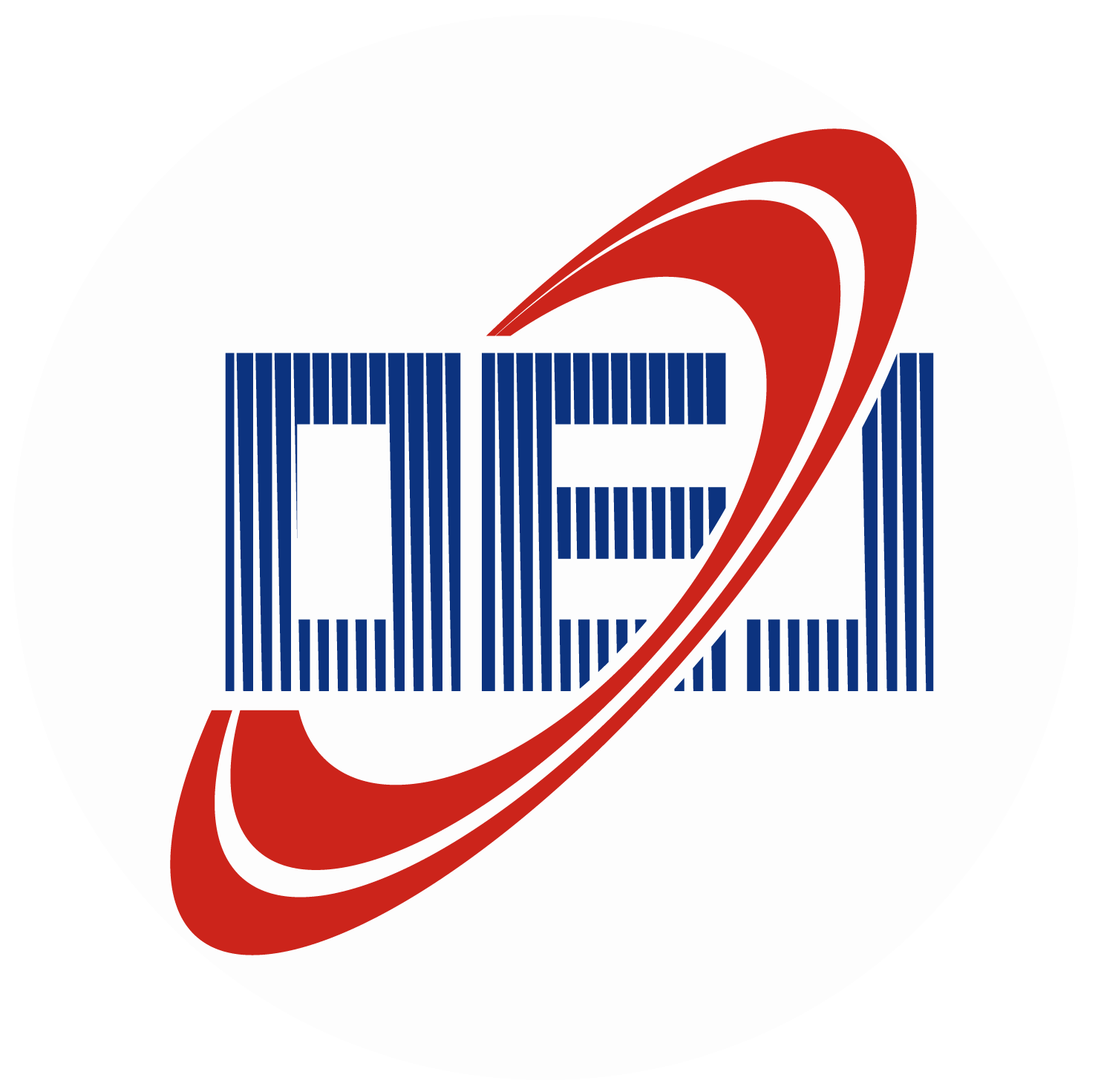

 E-mail Alert
E-mail Alert RSS
RSS
